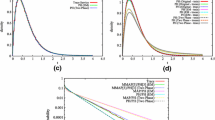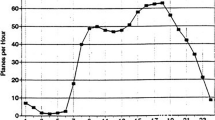Abstract
A single server commences its service at time zero every day. A random number of customers decide when to arrive to the system so as to minimize the waiting time and tardiness costs. The costs are proportional to the waiting time and the tardiness with rates \(\alpha \) and \(\beta \), respectively. Each customer’s optimal arrival time depends on the others’ decisions; thus, the resulting strategy is a Nash equilibrium. This work considers the estimation of the ratio \(\displaystyle \theta \equiv \beta /(\alpha +\beta )\) from queue length data observed daily at discrete time points, given that customers use a Nash equilibrium arrival strategy. A method of moments estimator is constructed from the equilibrium conditions. Remarkably, the method does not require estimation of the Nash equilibrium arrival strategy itself, or even an accurate estimate of its support. The estimator is strongly consistent, and the estimation error is asymptotically normal. Moreover, the asymptotic variance of the estimation error as a function of the queue length covariance matrix (at sampling times) is derived. The estimator performance is demonstrated through simulations and is shown to be robust to the number of sampling instants each day.












Similar content being viewed by others
References
Armero, C., Armero, M.J.: Bayesian prediction in M/M/1 queues. Queueing Syst. 15(1), 401–417 (1994)
Armero, C.: Bayesian inference in Markovian queues. Queueing Syst. 15(1), 419–426 (1994)
Asanjarani, A., Nazarathy, Y., Taylor, P.: A survey of parameter and state estimation in queues. Queueing Syst. 97, 1–42 (2021)
Basawa, I.V., Prabhu, N.U.: Large sample inference from single server queues. Queueing Syst. 3(4), 289–304 (1988)
Bhat, U.N., Rao, S.S.: Statistical analysis of queueing systems. Queueing Syst. 1(3), 217–247 (1987)
Bingham, N.H., Pitts, S.M.: Non-parametric estimation for the \(M/G/\infty \) queue. Queueing Syst. 51(1), 71–97 (1999)
Elsayed, E.A., Lee, M.K., Kim, S., Scherer, E.: Sequencing and batching procedures for minimizing earliness and tardiness penalty of order retrievals. Int. J. Prod. Res. 31(3), 727–738 (1993)
Glazer, A., Hassin, R.: ?/M/1: On the equilibrium distribution of customer arrivals. Eur. J. Oper. Res. 13(2), 146–150 (1983)
Hassin, R.: Rational Queueing. CRC Press, Boca Raton (2016)
Haviv, M.: When to arrive at a queue with tardiness costs? Perform. Eval. 70(6), 387–399 (2013)
Haviv, M., Ravner, L.: Strategic timing of arrivals to a finite queue multi-server loss system. Queueing Syst. 81(1), 71–96 (2015)
Haviv, M., Ravner, L.: A survey of queueing systems with strategic timing of arrivals. Queueing Syst. 81(1), 163–198 (2021)
Inoue, Y., Ravner, L., Mandjes, M.: Estimating customer impatience in a service system with balking (2020). arXiv:2005.03576
Jain, R., Juneja, S., Shimkin, N.: The concert queueing game: to wait or to be late. Discrete Event Dyn. Syst. 21(1), 103–138 (2011)
Juneja, S., Shimkin, N.: The concert queueing game: strategic arrivals with waiting and tardiness costs. Queueing Syst. 74(4), 369–402 (2013)
Kallenberg, O.: Foundations of Modern Probability, vol. 2. Springer, New York (1997)
Loeve, M.: Probability Theory I. Springer, New York (1977)
Ravner, L.: Equilibrium arrival times to a queue with order penalties. Eur. J. Oper. Res. 239(2), 456–468 (2014)
Robinson, L.W., Chen, R.R.: Estimating the implied value of the customer’s waiting time. Manuf. Serv. Oper. Manag. 13(1), 53–57 (2011)
Sherzer, E., Kerner, Y.: When to arrive at a queue with earliness, tardiness and waiting costs. Perform. Eval. 117, 16–32 (2017)
van der Vaart, A.W.: Asymptotic Statistics, vol. 3. Cambridge University Press, Cambridge (2000)
Wardrop, J.G.: Road paper. some theoretical aspects of road traffic research. Proc. Inst. Civ. Eng. 1(3), 325–362 (1952)
Acknowledgements
The authors would like to thank Peter Taylor for his valuable comments and advice. J. Wang would like to thank the University of Melbourne for supporting her work through the Melbourne Research Scholarship and the Albert Shimmins Fund.
Author information
Authors and Affiliations
Corresponding author
Additional information
Publisher's Note
Springer Nature remains neutral with regard to jurisdictional claims in published maps and institutional affiliations.
Appendices
Appendix A: Discrete approximation
This section explains how \(F_e\) can be numerically approximated. If we denote a general arrival distribution by F and its probability density function by f, then the arrival process is a non-homogeneous Poisson process with intensity measure \(\lambda f(t)\) for all \(t\ge 0\). The queue length dynamics satisfy the Kolmogorov forward equations
The equilibrium arrival distribution \(F_e\) satisfies (2.1), (2.2), and a set of nonlinear differential equations, which do not admit an analytic expression. We adopt the finite difference method, which was also mentioned in Haviv and Ravner [12, Sect. 3.1, Algorithm 1] and was termed as a discrete approximation, to numerically obtain \(F_e\) and the associated expected cost.
To make the calculation of the expected queue length feasible, we truncate the queue length at K. Specifically, we assume that customers can choose to arrive at a time on a discrete grid \({\mathcal {T}} \equiv \{0, \delta , 2\delta , \ldots \}\), and the queue has a buffer size of K. When the value of \(\delta \) is very small, with high probability there is at most one event happening in \(\delta \), thus for \(r = 1,2,\ldots \) and \(k = 0,1, \ldots , K\), the queue length dynamics \(P_k\) on \({\mathcal {T}}\) satisfy
which are the finite difference scheme applied to Eqs. (A.1) and (A.2). The expected cost
where \(q(r\delta ) \equiv \sum _{k=1}^{K}k P_k(r\delta )\) is the approximated expected queue length at slot r. For convenience, we drop the subscript F, and let the expected value and dynamics be that under the given arrival distribution for the rest of the paper. Increasing K or decreasing \(\delta \) clearly improves the accuracy of the approximation, but this is at the expense of calculation speed. We set \(K = \min \{m: \sum _{k = 0}^{m} {\lambda ^k \, e^{-\lambda }}/k! \ge 1-10^{-6}\}\), and \(\delta = 0.001\) throughout the paper.
The values of \(t_a\) and \(t_b\) are approximated by \(r_a \delta \) and \(r_b\delta \). In the following, we explain how to find \(p_e\), \(r_a\), \(r_b\), and \(f_e\) on \({\mathcal {T}}\cap [r_a\delta , r_b\delta ]\). In each iteration, when the value of \(p_e\) is given, the expected cost \({{\,\mathrm{{\mathbb {E}}}\,}}[C(0)]\) faced by customers arriving at time zero can be calculated. It follows from [10] that \(F_e\) has a zero density along the interval \((0,t_a)\), which means \(f(r \delta ) = 0\) until \(r \ge r_a\). For \(r = 1,2, \ldots , r_a\), since \(f(r\delta ) = 0\), the queue length dynamics at time \(r\delta \) can be calculated using Eqs. (A.3)–(A.5), the expected cost faced by a customer arriving at \(r\delta \) can then be determined. The reason for \(f_e(t) = 0, t \in (0,t_a)\) is that the expected cost faced by customers arriving at anytime in \((0,r_a \delta )\) is greater than \({{\,\mathrm{{\mathbb {E}}}\,}}[C(0)]\), which can also be inferred from Eq. (2.8). Hence, to determine the value of \(r_a\), we keep computing the queue dynamics, and then the expected cost for \(t = r \delta \) from \(r =1\) until \({{\,\mathrm{{\mathbb {E}}}\,}}[C(t)] \le {{\,\mathrm{{\mathbb {E}}}\,}}[C(0)]\), then \(r_a = \inf \{r: {{\,\mathrm{{\mathbb {E}}}\,}}[C(r \delta )] \le {{\,\mathrm{{\mathbb {E}}}\,}}[C(0)], r \ge 1\}\). In Haviv [10], the author calculated \(t_a\) by working out the expression of the expected cost at time \(t \in (0,t_a)\). Here, we use an alternative way and provide a more detailed explanation of the method in Haviv [10] and its comparison with our method in Remark 4.
For \(r \ge r_a\), the arrival density \(f(r\delta )\) is defined by Eq. (2.1), then the queue length dynamics can be obtained using Eqs. (A.3)–(A.5). We keep calculating \(f(r\delta )\) and the queue length dynamics until \(f(r\delta ) \le 0\), and \(r_b = \inf \{r: f(r\delta ) \le 0, r > r_a \}\). Thus, given the value of \(p_e\), the values of \(r_a\), \(r_b\), and \(f(r\delta )\) in \([r_a\delta , r_b \delta ]\) can be determined. Another condition that \(p_e\), \(f_e\), \(r_a\) and \(r_b\) need to satisfy is
Hence, we can initially guess a value for \(p_e\), and then adjust it iteratively using the bisection method until Eq. (A.7) is satisfied. Specifically, we start with \(p_1 = 0, p_2 = 1\), and always set \(p_e=\displaystyle \frac{p_1+p_2}{2}\). At the end of each iteration, we set \(p_2 = p_e\) if the total probability is greater than one, and \(p_1 = p_e\) otherwise. This calculation process is summarized in Algorithm 2.
Remark 4
The arrival distribution has zero density in \((0,t_a)\), so given \(p_e\) at time zero, the expected waiting time faced by a customer if she arrives at any time \(t \le t_a\) has an analytic expression. This expression was derived in Haviv [10, Lemma 3.3], where the author proposed two methods to calculate its quantity. One method is computing it with the assistance of Bessel’s functions, and the other method is estimating it using a Monte Carlo simulation procedure. The goal of working out the expression is to find the time at which if a customer arrives, her expected cost will be the same as the expected cost if she arrives at time 0. In our work, we do not adopt the expression of \(t_a\), but keep calculating the expected cost until it is no longer greater than \({\mathbb {E}}[C(0)]\) and note down the time \(\inf \{r: {{\,\mathrm{{\mathbb {E}}}\,}}[C(r \delta )] \le {{\,\mathrm{{\mathbb {E}}}\,}}[C(0)], r \ge 1\}\). Although our method to estimate \(t_a\) does not use the analytical properties of \(t_a\), it performs very well. In fact, in all the numerical examples we tried, it calculated \(t_a\) faster.
Appendix B: Algorithms
1.1 Appendix B.1 The approximated expected queue length

1.2 Appendix B.2 The case with no arrivals before time 0

1.3 Appendix B.3 Finite closing time

1.4 Appendix B.4 The case with arrivals before time 0

Rights and permissions
Springer Nature or its licensor (e.g. a society or other partner) holds exclusive rights to this article under a publishing agreement with the author(s) or other rightsholder(s); author self-archiving of the accepted manuscript version of this article is solely governed by the terms of such publishing agreement and applicable law.
About this article
Cite this article
Ravner, L., Wang, J. Estimating customer delay and tardiness sensitivity from periodic queue length observations. Queueing Syst 103, 241–274 (2023). https://doi.org/10.1007/s11134-022-09867-3
Received:
Revised:
Accepted:
Published:
Issue Date:
DOI: https://doi.org/10.1007/s11134-022-09867-3




